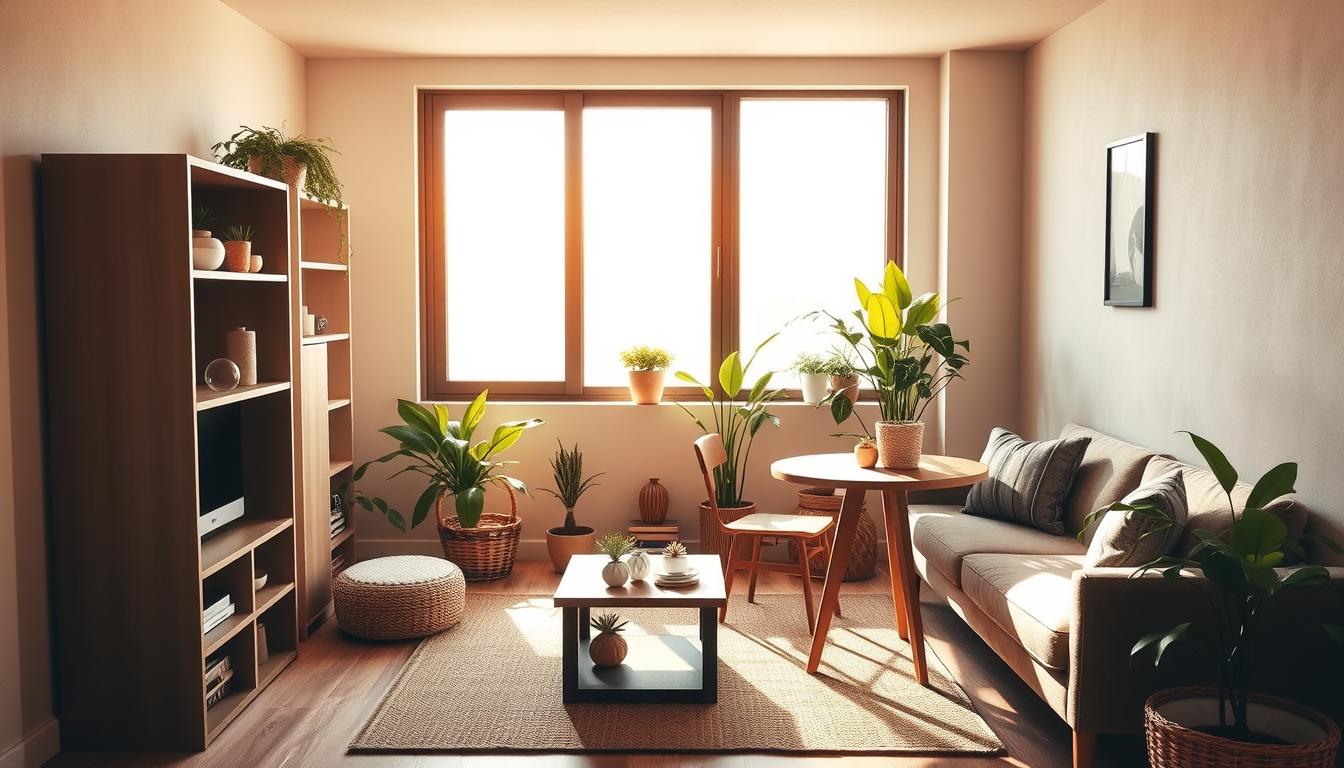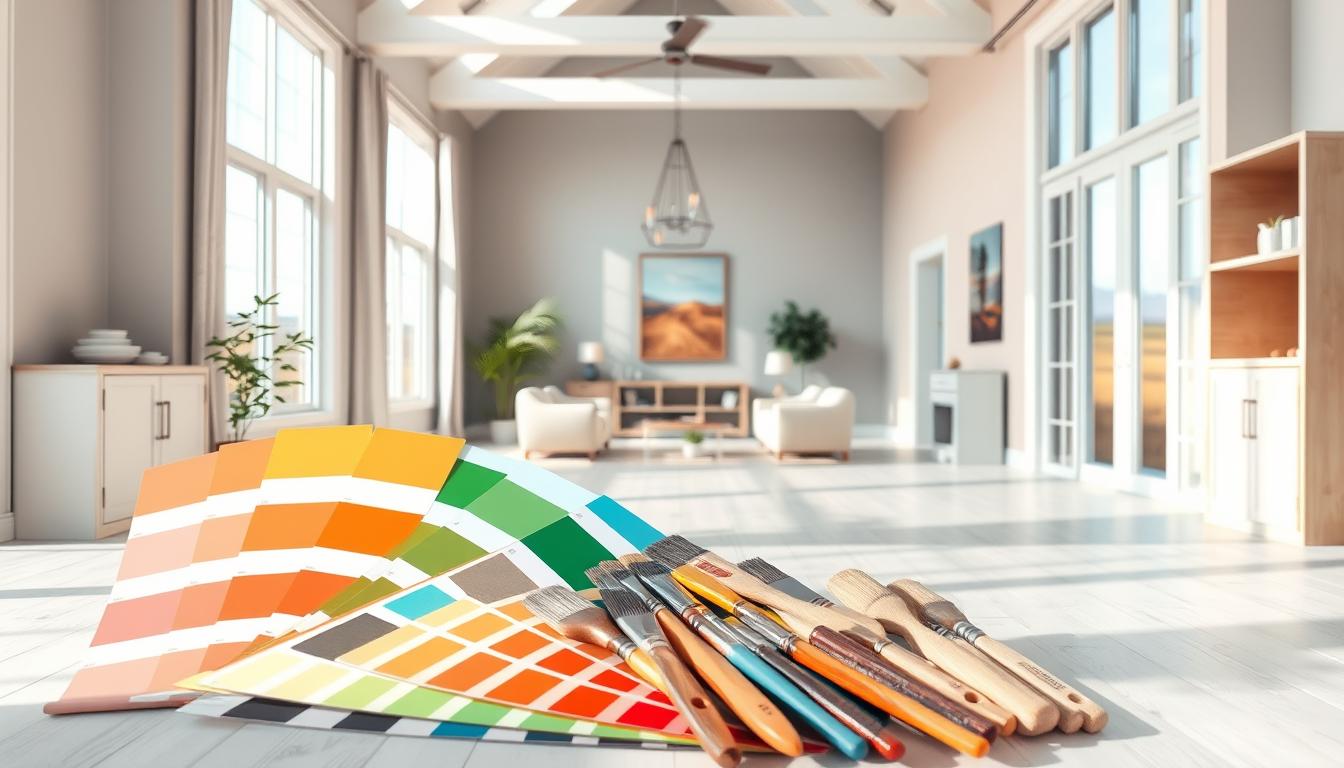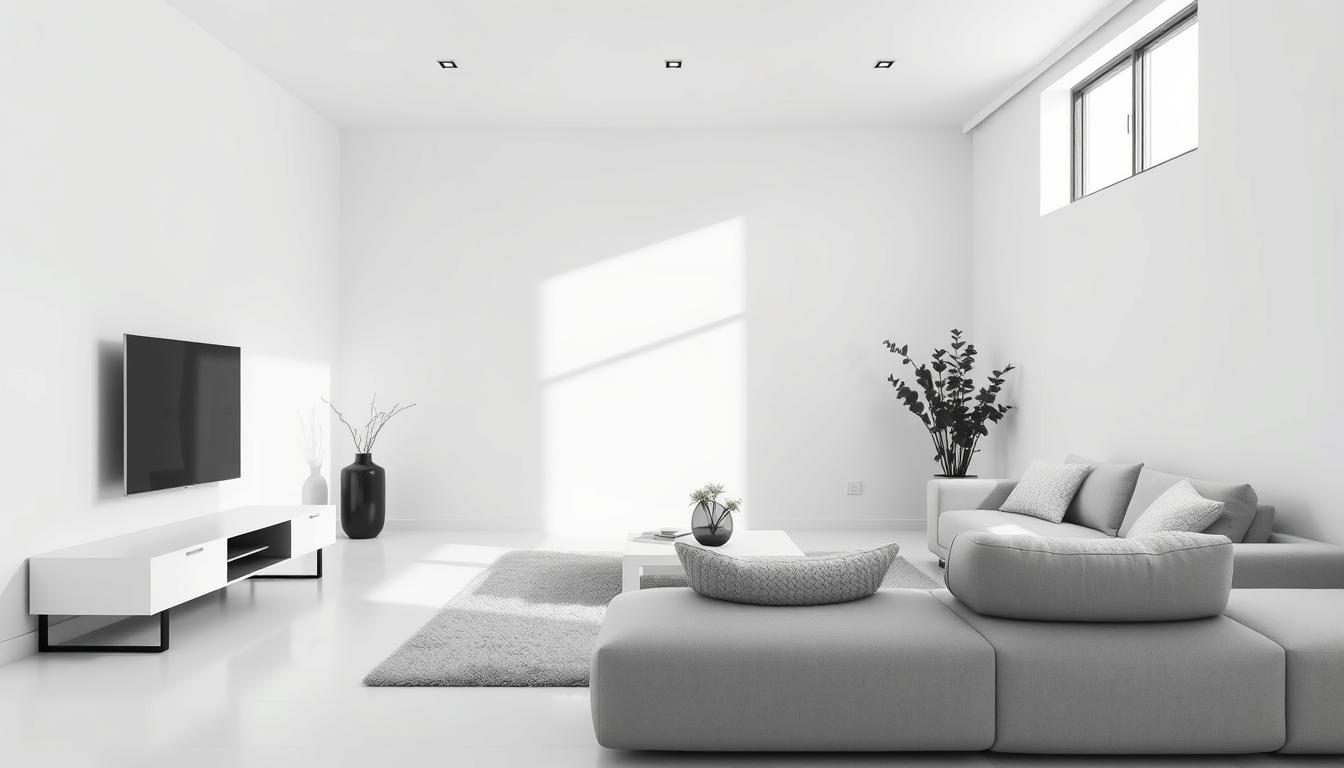As we embrace minimalist living, designing tiny home interiors is more popular than ever. With homes getting smaller, the need for smart and stylish small space design is huge.
We’ll show you how to make a small space both functional and beautiful. Our guide will teach you the key to small space design. You’ll get the tools and ideas to turn your tiny home into a cozy haven.
Key Takeaways
- Understand the principles of efficient small space design
- Learn how to maximize storage in tiny homes
- Discover the importance of multi-functional furniture
- Explore design strategies for creating the illusion of more space
- Get inspired by creative ideas for tiny home interiors
Understanding the Tiny Home Movement
The tiny home movement is appealing for many reasons. It’s about living smaller and caring for the planet. It’s not just about size; it’s a lifestyle choice.
The Appeal of Tiny Living
Many people are drawn to tiny living for different reasons. Some want to simplify their lives and get rid of clutter. Others see it as a way to live more sustainably and reduce their environmental impact.
The minimalist aspect of tiny living is also attractive. It encourages people to focus on what’s truly important. This means letting go of things they don’t need.
Another big plus of tiny living is the sense of community. Tiny home dwellers often join communities or villages. Here, they can share resources, knowledge, and support with others who share their values.
Environmental Benefits
One key benefit of tiny homes is their environmental impact. They are often more energy-efficient and use fewer resources than traditional houses. They also use sustainable materials and practices, which helps reduce their ecological footprint.
The environmental benefits of tiny homes include several key areas:
| Benefit | Description | Impact |
|---|---|---|
| Reduced Energy Consumption | Tiny homes use less power for heating, cooling, and lighting. | Lower carbon emissions |
| Minimal Material Usage | Building tiny homes requires fewer materials, reducing waste and the demand for new resources. | Less environmental degradation |
| Sustainable Practices | Many tiny homes use sustainable practices, such as rainwater harvesting and composting toilets. | Reduced water consumption and waste |
Economic Advantages
The tiny home movement also offers economic benefits. Buying or building a tiny home is often much cheaper than a traditional house. This makes homeownership more accessible to more people.
Also, tiny homes are often cheaper to maintain. They have lower utility bills and need fewer repairs. This makes them appealing to those looking to simplify their finances and reduce their cost of living.
Key Principles of Tiny Home Design
Exploring tiny home interiors shows us key design principles. Designing a tiny home means focusing on efficiency and function. This creates a cozy living space.
Functionality First
Functionality is key in tiny home design. We aim for an efficient home layout that does it all. For example, a kitchen island can be for cooking and dining.
Maximizing Vertical Space
Using vertical space is vital in small space design. Wall-mounted shelves, storage, and loft beds increase space. They keep the floor open and make the home feel bigger.
Multi-Use Furniture
Multi-use furniture boosts a tiny home’s function. Sofa beds, storage ottomans, and foldable tables are great. They let us change the space as needed, making it more useful.
These principles help make tiny homes beautiful, functional, and comfy. Tiny home design is about finding balance. It’s about making every piece count.
Creating an Open Layout
An open layout is key in tiny home design. It makes the space feel bigger and more airy. We’ll look at how to keep it open yet functional.
Benefits of Open Floor Plans
Open floor plans are great for tiny homes. They make the space feel united and flow well. Without walls, the area looks larger. Plus, they help people interact better and let in more natural light.
Some key advantages include:
- Increased sense of space
- Improved social interaction
- Better natural light penetration
- Enhanced flexibility in furniture arrangement
Defining Spaces Visually
Even with an open layout, it’s important to define areas. Use area rugs, different lights, and smart furniture placement to do this.
Clever Zoning Techniques
Zoning techniques help make separate areas in an open layout. Use partial walls, sliding partitions, or multi-functional furniture to zone a tiny home.
| Zoning Technique | Description | Benefit |
|---|---|---|
| Partial Walls | Half-walls that separate areas without fully enclosing them. | Creates separation while maintaining openness. |
| Sliding Partitions | Movable walls that can be opened or closed as needed. | Offers flexibility in space division. |
| Multi-functional Furniture | Furniture that serves more than one purpose. | Enhances space efficiency. |
Open layouts and smart zoning make tiny homes spacious and functional. It’s about finding a balance between openness and defined areas.
Choosing the Right Color Palette
In tiny home design, picking the right color palette is key. It’s not just about looks; it also makes the space feel bigger. The colors we pick can greatly change how our tiny home feels.
Light Colors for Space Illusion
Using light colors on walls, ceilings, and floors is a smart move. Light colors reflect light, making the space feel more open. White, cream, and pale gray are top picks for tiny homes because they make the space feel connected and flowing.
Accent Colors for Personality
While light colors make a tiny home feel bigger, accent colors add personality. Accent colors can be used sparingly through furniture, decor, or a bold wall. The trick is to mix them with the main light colors to keep the space balanced.
Trends in Tiny Home Colors
Today, tiny home colors are all about natural and earthy tones. Earth tones like sage green, sandy beige, and driftwood gray are calming and cozy. Soft pastels are also back, adding whimsy and softness to tiny home interiors.
When picking colors for your tiny home, think about how colors affect us and the space. Balance light colors with accent colors and keep up with trends. This way, your tiny home will feel spacious and uniquely yours.
Selecting Furnishings Wisely
In tiny home design, choosing the right furniture is key. The right pieces can make a small home feel big and cozy. The wrong ones can make it feel tight and messy.
Compact Furniture Options
When furnishing a tiny home, size matters. Compact furniture options are made to be small but useful. For instance, wall-mounted desks and foldable tables save space and can be tucked away when not needed.
Some top picks for small spaces include:
- Nesting tables that stack
- Ottomans with hidden storage
- Murphy beds that fold up
Custom Built-Ins
Custom built-ins are a smart way to use space in tiny homes. They’re made to fit perfectly, offering optimized storage and function. You can get everything from shelves to full wall systems with storage and work areas.
“Custom built-ins offer a tailored solution to the unique challenges of tiny home living, providing homeowners with the storage and functionality they need without sacrificing style or comfort.”
Multi-Functional Accessories
Multi-functional accessories also add value to tiny homes. These items do more than one thing, like a storage ottoman that’s also a seat.
Here are some examples:
- Storage bins that also decorate
- Drop-leaf tables for dining or work
- Hidden storage in furniture
By picking the right furniture, built-ins, and accessories, you can make your tiny home both useful and beautiful.
Optimizing Storage Solutions
Creating space in tiny homes needs creativity and planning. We must look beyond usual storage ideas to use every inch wisely.
Utilizing Under-Utilized Spaces
Using spaces we often ignore is a smart move. This includes spots under beds, stairs, and behind walls. We can add hidden compartments or under-bed storage to keep things tidy yet reachable.
For example, bed risers or storage bins under beds can hold lots of items. Stairs can also have built-in drawers or cabinets, making them useful for storage.
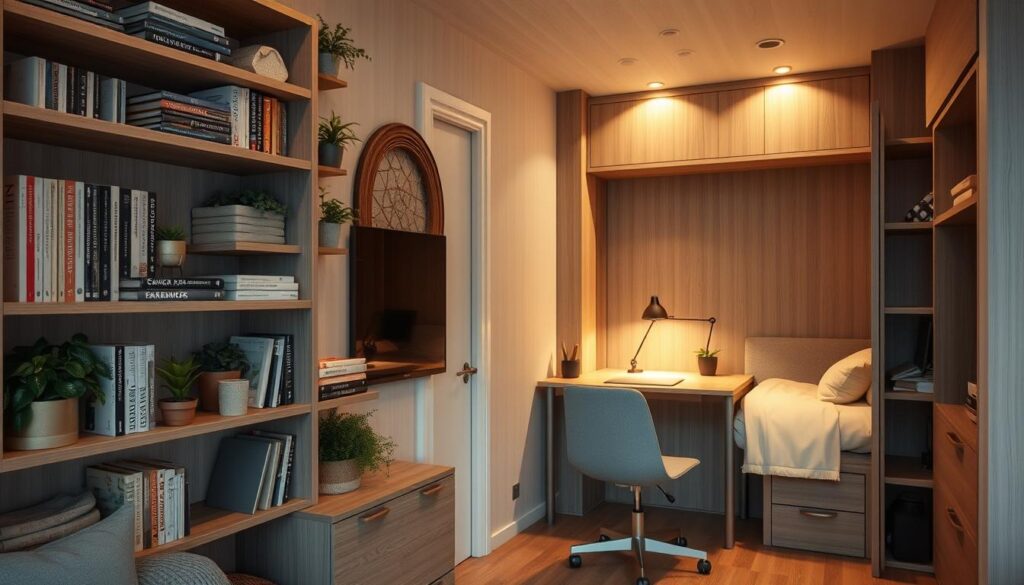
Creative Storage Ideas
Being creative is crucial for storage in tiny homes. We can use many innovative storage solutions such as:
- Wall-mounted shelves and hooks
- Foldable furniture that doubles as storage
- Hanging organizers for closets
- Magnetic strips for kitchen utensils
These ideas help keep our homes tidy and look good. They support a minimalist style.
Seasonal Storage Solutions
Storing seasonal items can be tough in tiny homes. We can use vacuum storage bags for bulky items like winter clothes. Stackable containers are great for decorations or sports gear.
It’s important to label these containers. This makes it easy to find what we need. It helps keep our tiny home organized all year.
As
“The ability to simplify means to eliminate the unnecessary so that the necessary may speak.” – Hans Hofmann
Keeping our storage simple is key in tiny homes. It helps us live more efficiently and sustainably.
Incorporating Natural Light
Maximizing natural light is key in tiny home design. It makes spaces feel larger and more welcoming. Natural light also boosts the home’s beauty.
Windows: The Primary Source of Natural Light
Windows are the main source of natural light in tiny homes. Large windows or sliding glass doors let in more light. It’s important to place windows right to get sunlight all day.
Windows on opposite sides create a cross breeze. This lets light reach deeper into the room. Low-E windows also save energy by keeping heat out in winter and in summer.
Skylights and Their Benefits
Skylights bring light into tiny homes where walls are tight. They’re installed in ceilings to let sunlight in from above.
Skylights offer ventilation options too. They help control the home’s temperature. Some open to let in fresh air, cutting down on the need for fans or air conditioners.
Choosing Transparent Materials
Transparent or translucent materials add to natural light in tiny homes. Transparent partitions or glass dividers keep spaces open without blocking light.
For more tips on using natural light in tiny homes, check out United Tiny Homes.
| Element | Benefits | Considerations |
|---|---|---|
| Windows | Natural Light, Ventilation | Placement, Size, Energy Efficiency |
| Skylights | Natural Light, Ventilation | Installation, Insulation |
| Transparent Materials | Open Feel, Natural Light | Privacy, Insulation |
Personalizing Your Tiny Home
Making a tiny home your own is more than just picking furniture. It’s about adding personal touches that tell your story. These touches turn small spaces into warm, inviting homes.
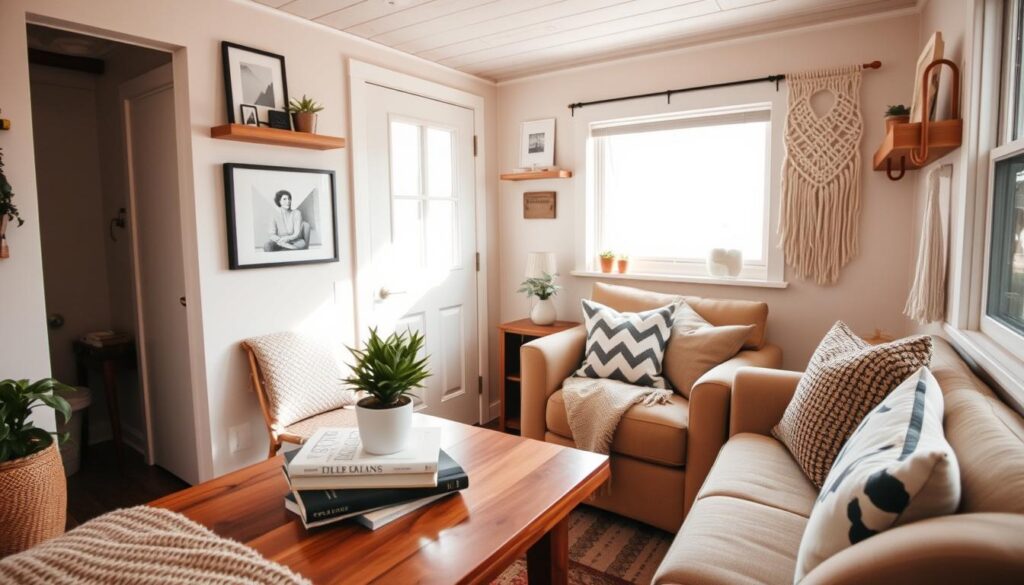
Adding Personal Touches
Personal touches can be family photos, heirlooms, or personal mementos. These add character and make your home feel larger. “The most important thing is to make your space feel like you,” says interior designer Jane Smith. “Incorporating personal items can make even the smallest spaces feel incredibly cozy and inviting.”
Display personal items on shelves or in shadow boxes to keep them organized. Use throw blankets and rugs to add color and texture that shows your personality.
The Role of Art and Decor
Art and decor are key in making your tiny home personal. Choose pieces that resonate with you to enhance your space’s ambiance. For a minimalist look, pick a few statement pieces instead of many.
As minimalist living advocates say, less is more. Focus on a few decor items that speak to you. Use them to create a cohesive look in your home.
Tips for Effective Theming
Theming your tiny home can create a cohesive look and feel. Whether you prefer a coastal vibe, rustic retreat, or modern minimalist look, there are ways to achieve it.
- Start with a color palette that reflects your theme.
- Choose furniture and decor that aligns with your chosen aesthetic.
- Use lighting to enhance the ambiance of your space.
By following these tips, you can make a tiny home that looks great and feels like you.
“The way we design our homes is a reflection of who we are and how we want to live our lives.”
Outdoor Connection and Integration
In tiny home design, the outdoors is a key part of the living area. As we guide you through designing tiny home interiors, think about how outdoor spaces can improve your living experience.
Expanding Living Space Outdoors
One great way to use tiny home space is by making the outdoors part of your living area. Create outdoor spaces that feel like they’re part of your home.
Adding an outdoor kitchen or dining area is a smart move. It gives you more room for cooking and eating. Plus, it lets you live a bigger lifestyle.
Benefits of Outdoor Living Spaces:
- More room to live
- Deeper connection with nature
- Space for more fun activities
Outdoor Furniture Ideas
Choosing the right outdoor furniture for tiny homes is key. Look for pieces that are small, useful, and can stand up to the weather.
| Furniture Type | Characteristics | Benefits |
|---|---|---|
| Modular Furniture | Flexible, multi-functional | Adapts to different spaces and needs |
| Foldable Furniture | Space-saving, easy to store | Perfect for tiny homes with little storage |
| Recycled Plastic Furniture | Durable, eco-friendly | Good for the planet and outdoor decor |
Landscaping for Tiny Homes
Landscaping around a tiny home can really change how it looks and works. Think about using native plants. They need less care and water.
“Landscaping is not just about beautifying the exterior; it’s about creating a harmonious relationship between the built environment and nature.”
For tiny homes, adding landscaping that gives privacy and defines outdoor areas is smart. This makes your outdoor space feel more like part of your home.
Landscaping Tips:
- Use native plants to reduce maintenance.
- Try vertical gardening to save space.
- Choose plants that block wind or provide shade.
By adding these outdoor elements, tiny home owners can enjoy a bigger and more connected living space.
Sustainable Design Elements
We aim to make eco-friendly tiny homes. We focus on design elements that cut down waste and make living better.
When designing tiny homes, we choose sustainability to lessen our impact on the environment. We add eco-friendly features to our designs.
Recycled Materials
Recycled materials are key in sustainable tiny home design. We use materials like reclaimed wood, old pallets, and recycled metal. This creates unique and useful spaces.
For example, reclaimed wood can be used for floors, walls, and furniture. It adds character and reduces the need for new lumber.
Benefits of Using Recycled Materials:
- Reduces waste and the demand for new resources
- Adds unique character to the tiny home
- Can be cost-effective
Energy Efficiency Solutions
Energy efficiency is crucial in tiny home design. We use energy-saving appliances, LED lights, and insulation to achieve this.
“Energy efficiency is not just about saving energy; it’s about creating a sustainable future.”
Solar panels are also a good choice for tiny homes. They provide clean energy and reduce grid reliance.
| Energy Efficiency Measure | Benefits |
|---|---|
| Energy-Efficient Appliances | Reduced energy consumption, lower utility bills |
| LED Lighting | Longer lifespan, reduced energy consumption |
| Proper Insulation | Reduced heat loss, improved comfort |
Water Conservation Techniques
Water conservation is vital in tiny home design. We use low-flow fixtures and greywater systems to save water.
Low-flow showerheads and toilets help cut down water use. They do so without sacrificing comfort.
By using these sustainable design elements, we create tiny homes that are eco-friendly, comfortable, and functional.
Trends in Tiny Home Interiors
Exploring tiny home interiors reveals several trends. These trends meet different tastes and needs. The secret to a beautiful tiny home is balancing form and function. This creates a space that feels both spacious and welcoming.
Design Philosophies
The debate between minimalist and maximalist design is key. Minimalism focuses on simplicity and clean lines. Maximalism, on the other hand, celebrates bold colors and eclectic decor. Mixing both can create a space that truly reflects our personality.
Smart Technology Integration
Smart home technology is a big trend. Adding smart lighting, temperature control, and security systems boosts our tiny homes’ functionality. It makes living in them more efficient and enjoyable.
Nature-Inspired Design
Biophilic design is also on the rise. It connects us to nature in small spaces. Using natural materials, plants, and plenty of light creates harmony and well-being in our tiny homes.

